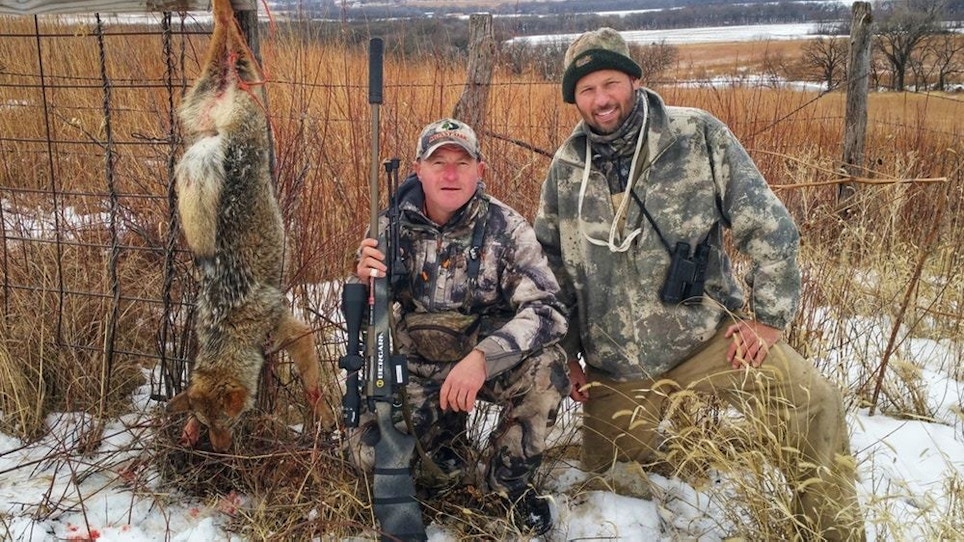
Mark Kayser, left, and Chad Serrault knock down a few predators after switching calling sequences. (Photo: Mark Kayser)
Don’t get stuck in a rut like me. My rut, besides the obvious stuck truck in a deep, muddy rut, is my tendency to work my calls entirely for coyotes. That negates nearly any other predator arriving at my calling location.
For many of my sets it’s a wise move as the barren, Western landscape holds more coyotes than anything else. For bobcats or fox, a more targeted environment for these species would need to be hunted. Thick riparian cover would be more ideal for bobcats and greenway areas near urbanization might hold a red fox family; at least in my ZIP code anyway.
The problem with getting in a rut is that you tend to take it with you. On a recent hunting trip to Kansas I was all set to start out my sets with the announcement of a solitary coyote letting the tall grass prairie know it was in the vicinity. That was until I talked with local predator hunter Chad Serrault. Although Serrault spends his weekdays as an equipment installer for a major communications company, his true passion is hunting and predators take top billing.
I met Serrault through another friend of mine, Dr. Kenny Fischer, and soon we were scheming in the cab of a truck before shooting light. As the guest to a first-rate Kansas predator hunt I obliged and gave Serrault full run of the calls. I figure it is best to sit back and watch how locals do it. Not only am I curious, but I typically learn some new tactics.
We split up minutes before shooting light. I was going to take a position overlooking one portion of a food plot and he was watching an edge on the opposite side. Serrault started and continued to use a series of birds in distress calls for the setup, changing species every five minutes or so. Fifteen minutes into the set a rapid succession of AR shots had me scanning for escapees. I quickly caught sight of a coyote ducking back into cover.
After a few more minutes of calling we reconnected and Serrault said the coyote must have smelled us. All he was afforded was a fleeing shot. I never saw the coyote until the shooting started, but that’s not at all surprising in the tall Kansas grasslands.
When I queried him on the bird calls it soon became obvious why Tweety is a top choice. Serrault explained that bobcats are healthy and live in the crossover country that the coyotes also call home. A constant, nearly nonstop chatter of bird sounds lures the cats, but can also bring a coyote charging to the call as we witnessed. Here’s Serrault’s tips if you want to have a chance at one or the other, or both.
- Use bird calls to start your setup and continue to use them at least 15 to 30 minutes.
- Keep the bird calls going nearly nonstop as bobcats require ongoing incentive to make an appearance.
- Use a decoy that dances in conjunction with your call to mesmerize a bobcat like your housecat watches its favorite toy.
- Finally, if no bobcat has appeared after 30 minutes, go to your coyote sounds, including vocalizations, to end your set.
On our third setup I was in position to finally catch sight of a coyote that had drifted past Serrault in heavy cover and suddenly appeared in a brushy shooting lane below me. I settled my Sig Sauer reticle on the coyote, one step away from diving into a dry creek bed, and sent a Hornady Match bullet from my Bergara 6mm Creedmoor to halt the escape. It was the start of several hours of the best coyote action I’ve had in quite some time.
We didn’t call in a coyote, but that’s reason enough to plan another trip back to Kansas.





